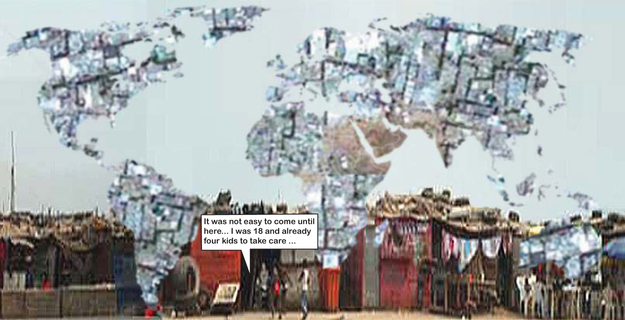We intend to use the Web 2.0 technology as a tool to research slums in Luanda – Angola. These informal settlements are an opportunity to think globally and to examine an urban phenomenon that has not been sufficiently documented on the internet and is detached from the architecture and town planning practice. An investigation using this particular technology facilitates a crossing between slum mapping and the inhabitant’s communal memory, art initiatives and relevant historical facts. Our research will provide clues which contradict opposed segregation models and other urban social pathologies.
Working steps
• Locally observe, assemble, document and archive.
• Slum mapping collaboration by young slum dwellers with the help of a mobile GPS system.
• Communal memory compilation by interviewing old slum dwellers.
• Translation of the result of our investigation into programmatic maps and online testimonies.
• Gathering links of slum webmates into a global network.
What would you like to achieve? And why?
Slum settlements became a subject of research due to their proliferation in Luanda, Africa. There is a need to investigate these urban dwellings and give a voice to slum dwellers. More important is the need to preserve their survival strategies, knowledge and communal interaction.
Who is the target audience?
We would like Slum Up to reach a young generation of slum dwellers first, more receptive to new technologies and in need of communal memories. Secondly we would like to collaborate with wikimapers and webmates, to develop a slum mapping network.
What makes your project innovative? New target audience, new type of partnerships, new distribution mechanisms, new product, new way of working?
The innovation of this proposal rests mainly in the crossing between slum mapping and communal memory that are often disconnected by town planners, politicians and NGOs. Above all this project’s success is dependent on the active participation of the slum dwellers.
The final result of Slum Up will be a website documenting the slums of Luanda, the model can replicate in other slums.
Last but not least, the exchange of information generated with the website will have a butterfly effect on slum awareness, stimulating a discussion on the need for the gradual development of these informal settlements.
Why is the use of the Web2.0 important for your project?
The Web 2.0 technology is used as a tool to research informal settlements and increase the exchange of survival strategies and knowledge, providing interaction among a global slum community. This archive will be available online for future generations whose task is to pass on the communal memories.
